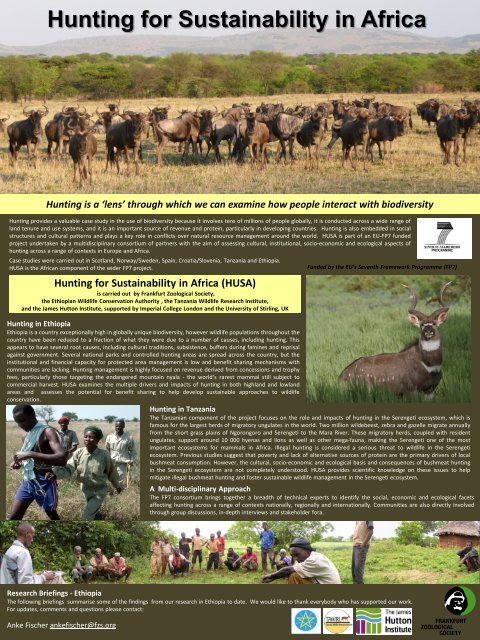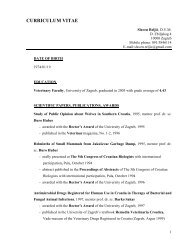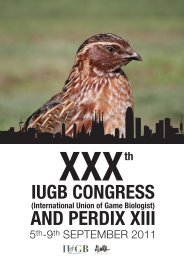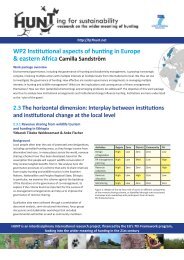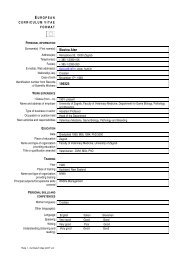Hunting for Sustainability in Africa
Hunting for Sustainability in Africa
Hunting for Sustainability in Africa
Create successful ePaper yourself
Turn your PDF publications into a flip-book with our unique Google optimized e-Paper software.
<strong>Hunt<strong>in</strong>g</strong> <strong>for</strong> <strong>Susta<strong>in</strong>ability</strong> <strong>in</strong> <strong>Africa</strong><br />
<strong>Hunt<strong>in</strong>g</strong> <strong>for</strong> <strong>Susta<strong>in</strong>ability</strong> <strong>in</strong> <strong>Africa</strong> – Ethiopia Research Brief<strong>in</strong>gs<br />
<strong>Hunt<strong>in</strong>g</strong> is a ‘lens’ through which we can exam<strong>in</strong>e how people <strong>in</strong>teract with biodiversity<br />
<strong>Hunt<strong>in</strong>g</strong> provides a valuable case study <strong>in</strong> the use of biodiversity because it <strong>in</strong>volves tens of millions of people globally, it is conducted across a wide range of<br />
land tenure and use systems, and it is an important source of revenue and prote<strong>in</strong>, particularly <strong>in</strong> develop<strong>in</strong>g countries. <strong>Hunt<strong>in</strong>g</strong> is also embedded <strong>in</strong> social<br />
structures and cultural patterns and plays a key role <strong>in</strong> conflicts over natural resource management around the world. HUSA is part of an EU-FP7 funded<br />
project undertaken by a multidiscipl<strong>in</strong>ary consortium of partners with the aim of assess<strong>in</strong>g cultural, <strong>in</strong>stitutional, socio-economic and ecological aspects of<br />
hunt<strong>in</strong>g across a range of contexts <strong>in</strong> Europe and <strong>Africa</strong>.<br />
Case studies were carried out <strong>in</strong> Scotland, Norway/Sweden, Spa<strong>in</strong>, Croatia/Slovenia, Tanzania and Ethiopia.<br />
HUSA is the <strong>Africa</strong>n component of the wider FP7 project.<br />
<strong>Hunt<strong>in</strong>g</strong> <strong>for</strong> <strong>Susta<strong>in</strong>ability</strong> <strong>in</strong> <strong>Africa</strong> (HUSA)<br />
is carried out by Frankfurt Zoological Society,<br />
the Ethiopian Wildlife Conservation Authority , the Tanzania Wildlife Research Institute,<br />
and the James Hutton Institute, supported by Imperial College London and the University of Stirl<strong>in</strong>g, UK<br />
<strong>Hunt<strong>in</strong>g</strong> <strong>in</strong> Ethiopia<br />
Ethiopia is a country exceptionally high <strong>in</strong> globally unique biodiversity, however wildlife populations throughout the<br />
country have been reduced to a fraction of what they were due to a number of causes, <strong>in</strong>clud<strong>in</strong>g hunt<strong>in</strong>g. This<br />
appears to have several root causes, <strong>in</strong>clud<strong>in</strong>g cultural traditions, subsistence, buffers dur<strong>in</strong>g fam<strong>in</strong>es and reprisal<br />
aga<strong>in</strong>st government. Several national parks and controlled hunt<strong>in</strong>g areas are spread across the country, but the<br />
<strong>in</strong>stitutional and f<strong>in</strong>ancial capacity <strong>for</strong> protected area management is low and benefit shar<strong>in</strong>g mechanisms with<br />
communities are lack<strong>in</strong>g. <strong>Hunt<strong>in</strong>g</strong> management is highly focused on revenue derived from concessions and trophy<br />
fees, particularly those target<strong>in</strong>g the endangered mounta<strong>in</strong> nyala - the world’s rarest mammal still subject to<br />
commercial harvest. HUSA exam<strong>in</strong>es the multiple drivers and impacts of hunt<strong>in</strong>g <strong>in</strong> both highland and lowland<br />
areas and assesses the potential <strong>for</strong> benefit shar<strong>in</strong>g to help develop susta<strong>in</strong>able approaches to wildlife<br />
conservation.<br />
Funded by the EU’s Seventh Framework Programme (FP7)<br />
<strong>Hunt<strong>in</strong>g</strong> <strong>in</strong> Tanzania<br />
The Tanzanian component of the project focuses on the role and impacts of hunt<strong>in</strong>g <strong>in</strong> the Serengeti ecosystem, which is<br />
famous <strong>for</strong> the largest herds of migratory ungulates <strong>in</strong> the world. Two million wildebeest, zebra and gazelle migrate annually<br />
from the short grass pla<strong>in</strong>s of Ngorongoro and Serengeti to the Mara River. These migratory herds, coupled with resident<br />
ungulates, support around 10 000 hyenas and lions as well as other mega-fauna, mak<strong>in</strong>g the Serengeti one of the most<br />
important ecosystems <strong>for</strong> mammals <strong>in</strong> <strong>Africa</strong>. Illegal hunt<strong>in</strong>g is considered a serious threat to wildlife <strong>in</strong> the Serengeti<br />
ecosystem. Previous studies suggest that poverty and lack of alternative sources of prote<strong>in</strong> are the primary drivers of local<br />
bushmeat consumption. However, the cultural, socio-economic and ecological basis and consequences of bushmeat hunt<strong>in</strong>g<br />
<strong>in</strong> the Serengeti ecosystem are not completely understood. HUSA provides scientific knowledge on these issues to help<br />
mitigate illegal bushmeat hunt<strong>in</strong>g and foster susta<strong>in</strong>able wildlife management <strong>in</strong> the Serengeti ecosystem.<br />
A Multi-discipl<strong>in</strong>ary Approach<br />
The FP7 consortium br<strong>in</strong>gs together a breadth of technical experts to identify the social, economic and ecological facets<br />
affect<strong>in</strong>g hunt<strong>in</strong>g across a range of contexts nationally, regionally and <strong>in</strong>ternationally. Communities are also directly <strong>in</strong>volved<br />
through group discussions, <strong>in</strong>-depth <strong>in</strong>terviews and stakeholder <strong>for</strong>a.<br />
Research Brief<strong>in</strong>gs - Ethiopia<br />
The follow<strong>in</strong>g brief<strong>in</strong>gs summarise some of the f<strong>in</strong>d<strong>in</strong>gs from our research <strong>in</strong> Ethiopia to date. We would like to thank everybody who has supported our work.<br />
For updates, comments and questions please contact:<br />
Anke Fischer ankefischer@fzs.org
<strong>Hunt<strong>in</strong>g</strong> <strong>for</strong> <strong>Susta<strong>in</strong>ability</strong> <strong>in</strong> <strong>Africa</strong> – Ethiopia Research Brief<strong>in</strong>gs<br />
Revenue shar<strong>in</strong>g from wildlife tourism and hunt<strong>in</strong>g<br />
Background<br />
• Local people often bear the cost of protected area designations, <strong>in</strong>clud<strong>in</strong>g controlled hunt<strong>in</strong>g areas, as<br />
they <strong>for</strong>ego <strong>in</strong>come from alternative land uses<br />
• In many places across the world, revenue shar<strong>in</strong>g schemes have thus been developed, based on the<br />
assumption that people will support wildlife conservation if they receive tangible benefits from it<br />
• We analyse here the governance processes of a scheme that aims to share revenues from trophy hunt<strong>in</strong>g<br />
and wildlife tourism <strong>in</strong> the Southern Nations, Nationalities and Peoples Regional State, Ethiopia<br />
• Qualitative data was collected through a comb<strong>in</strong>ation of document analysis, semi-structured <strong>in</strong>terviews,<br />
focus group discussions and stakeholder workshops that <strong>in</strong>cluded governmental authorities as well as<br />
community members<br />
Key f<strong>in</strong>d<strong>in</strong>gs<br />
• All study participants welcomed the scheme and saw it as<br />
work <strong>in</strong> progress. Four areas of the current legislation and<br />
implementation practice were seen to require improvement:<br />
– In<strong>for</strong>mation on the detail of the scheme was lack<strong>in</strong>g<br />
among many actors<br />
– Roles and responsibilities of the actors were imbalanced –<br />
district governments were very <strong>in</strong>fluential whereas local<br />
communities tended to be passive<br />
– Accountability was compromised, as limited provisions<br />
had been made <strong>for</strong> monitor<strong>in</strong>g and evaluation<br />
– Disbursement of the shares was usually not associated to<br />
hunt<strong>in</strong>g or tourism, and overall revenue was too limited<br />
to have an impact<br />
Conclusions<br />
Region<br />
Zone<br />
Districts<br />
Communities<br />
Protected Areas<br />
Fig.: In<strong>for</strong>mation flows between actors. Thicker l<strong>in</strong>es denote<br />
more frequent communication.<br />
• The revenue shar<strong>in</strong>g scheme was established <strong>in</strong> 2007, and it was thus too early to assess its impacts<br />
on conservation-related attitudes and behaviour. Our analysis of governance processes now <strong>in</strong><strong>for</strong>ms<br />
the government’s current revision of legislation and implementation practice<br />
• It seems unlikely that the scheme will lead to attitude and behaviour change among the local<br />
population <strong>in</strong> the future, given the miss<strong>in</strong>g connection between conservation-relevant behaviours<br />
and the amount of revenue distributed. This might be addressed by a turn towards co-management<br />
of the protected areas, where responsibility <strong>for</strong> wildlife is shared between government and local<br />
communities<br />
• However, at a political level, <strong>for</strong>malised revenue shar<strong>in</strong>g as <strong>in</strong> this scheme might help to make the<br />
monetary value of wildlife conservation visible, thus provid<strong>in</strong>g arguments aga<strong>in</strong>st land conversion<br />
Contact: Yitbarek Tibebe yitbarektibebe@fzs.org May 2012<br />
1/5
<strong>Hunt<strong>in</strong>g</strong> <strong>for</strong> <strong>Susta<strong>in</strong>ability</strong> <strong>in</strong> <strong>Africa</strong> – Ethiopia Research Brief<strong>in</strong>gs<br />
The role of women <strong>in</strong> hunt<strong>in</strong>g <strong>in</strong> lower Omo, Ethiopia<br />
Background<br />
• <strong>Hunt<strong>in</strong>g</strong> without a permit is illegal <strong>in</strong> Ethiopia. Partly due to such uncontrolled hunt<strong>in</strong>g, wildlife<br />
populations <strong>in</strong> many areas, <strong>in</strong>clud<strong>in</strong>g southern Ethiopia, have decl<strong>in</strong>ed substantially <strong>in</strong> recent years.<br />
Illegal hunt<strong>in</strong>g is thus a major conservation concern<br />
• <strong>Hunt<strong>in</strong>g</strong> by local residents of the lower Omo valley <strong>in</strong> southern Ethiopia, such as the Hamar, Mursi or<br />
Arbore, has received comparatively little academic attention, but is often portrayed as a male activity,<br />
focus<strong>in</strong>g on large game, connected to bravery and manhood<br />
• To provide <strong>in</strong>sights <strong>in</strong>to the cultural and social context of illegal<br />
hunt<strong>in</strong>g <strong>in</strong> lower Omo, we explore here the role of women<br />
Method<br />
• We analysed qualitative data from focus group discussions and<br />
<strong>in</strong>terviews <strong>in</strong> 7 villages (n=105 participants) <strong>in</strong>habited by Hamar,<br />
Bashada, Kara and Arbore ethnic groups. Separate discussions<br />
were held <strong>for</strong> women<br />
Results<br />
• Women played an important role <strong>in</strong> male hunt<strong>in</strong>g activities by actively encourag<strong>in</strong>g hunt<strong>in</strong>g and<br />
discourag<strong>in</strong>g non-hunt<strong>in</strong>g through a variety of verbal and non-verbal means. These <strong>in</strong>cluded, e.g., …<br />
– Ritualised activities: welcom<strong>in</strong>g a successful first-time hunter with symbolic gifts, songs and a<br />
ceremony<br />
– Preference <strong>for</strong> successful hunters as partners, and withdrawal of affection from non-hunt<strong>in</strong>g men<br />
– Praise <strong>for</strong> hunters, and <strong>in</strong>sults and explicit disregard of non-hunters<br />
• Non-hunt<strong>in</strong>g men were portrayed as a category <strong>in</strong> between ‘man’ and ‘woman’<br />
“Dur<strong>in</strong>g the danc<strong>in</strong>g, dur<strong>in</strong>g the songs, the girls will not choose the<br />
one who didn’t kill a buffalo. They choose only the killer.” (Man, age 50)<br />
Conclusions<br />
• Overall, female behaviours <strong>in</strong> relation to male hunt<strong>in</strong>g were very diverse and ritualised. However, the<br />
stark decl<strong>in</strong>e <strong>in</strong> wildlife meant that such rituals would nowadays only rarely be carried out<br />
• Still, hunt<strong>in</strong>g of large game has high cultural importance <strong>in</strong> lower Omo. It both contributes to and is<br />
encouraged by the def<strong>in</strong>ition of gender roles<br />
• Conservation <strong>in</strong>terventions that aim to address illegal hunt<strong>in</strong>g of large game need to consider<br />
<strong>in</strong>teractions between genders <strong>in</strong> order to be successful<br />
Contact: Degu Tadie degutadie@fzs.org May 2012<br />
2/5
<strong>Hunt<strong>in</strong>g</strong> <strong>for</strong> <strong>Susta<strong>in</strong>ability</strong> <strong>in</strong> <strong>Africa</strong> – Ethiopia Research Brief<strong>in</strong>gs<br />
<strong>Hunt<strong>in</strong>g</strong>, social structure and human-nature relationships<br />
Background<br />
• <strong>Hunt<strong>in</strong>g</strong> has often been portrayed as the ultimate <strong>for</strong>m of human-wildlife<br />
<strong>in</strong>teraction, emphasis<strong>in</strong>g the close connection between hunter and game<br />
• In southern Ethiopia, illegal hunt<strong>in</strong>g, usually described as a culturally<br />
important activity, is a conservation concern, due to stark decl<strong>in</strong>es <strong>in</strong><br />
wildlife populations<br />
• Can a better understand<strong>in</strong>g of the human-wildlife relationships enacted<br />
through hunt<strong>in</strong>g help us to address conservation concerns related to illegal<br />
hunt<strong>in</strong>g <strong>in</strong> the lower Omo valley, Ethiopia?<br />
• To address this question, we analysed qualitative data from focus group<br />
discussions and <strong>in</strong>terviews <strong>in</strong> 7 villages (n=105 participants), <strong>in</strong>habited by<br />
Hamar, Bashada, Kara and Arbore ethnic groups<br />
Key f<strong>in</strong>d<strong>in</strong>gs<br />
• <strong>Hunt<strong>in</strong>g</strong> helped people to develop and ma<strong>in</strong>ta<strong>in</strong> social structures beyond family bonds. <strong>Hunt<strong>in</strong>g</strong> of large<br />
game was central to the establishment of long-term relationships between two hunt<strong>in</strong>g friends (called<br />
misso) and between a successful first-time hunter and a girl, his ‘honorary elder sister’ (called misha).<br />
Misso and misha relationships could be seen as social capital which could be drawn on <strong>in</strong> difficult times<br />
• By contrast, hunt<strong>in</strong>g seem to hold very little mean<strong>in</strong>g <strong>for</strong> the hunters’ relationship to wildlife or nature.<br />
Study participants had recently experienced dramatic degradation of their environment (e.g.,<br />
disappearance of wildlife, lack of graz<strong>in</strong>g <strong>for</strong> livestock), but seemed to accept these changes <strong>in</strong> an almost<br />
fatalistic manner. Attempts to understand and expla<strong>in</strong> these changes were limited<br />
Conclusions<br />
“The girl will see<br />
him and say: ‘He is<br />
the hunter’, and<br />
run towards him<br />
and put her<br />
necklaces on him;<br />
she is called<br />
misha.”<br />
(Man, age 40)<br />
“We are worried about it. We don’t know; maybe the land turned upside<br />
down and brought up the soil, which we have never seen be<strong>for</strong>e. The land<br />
is bare; this is new <strong>for</strong> us. The cattle are there, the goats are there, but we<br />
don’t know whether they will be saved or perish. We are just here because<br />
we are born here and have nowhere to go.” Man, age 55<br />
• Overall, <strong>in</strong> lower Omo, hunt<strong>in</strong>g was important to establish relationships between people, but did not seem<br />
relevant <strong>for</strong> develop<strong>in</strong>g relationships with nature or wildlife, or knowledge about the natural environment.<br />
Ironically, this strong focus on social relations might contribute to the disappearance of hunt<strong>in</strong>g and its<br />
social functions<br />
• The social importance of resource use practices (such as hunt<strong>in</strong>g), human-nature relationships and the<br />
ways how knowledge about the environment is acquired need to be understood to create a mean<strong>in</strong>gful<br />
basis <strong>for</strong> conservation and development <strong>in</strong>terventions. Contact: degutadie@fzs.org May 2012<br />
3/5
<strong>Hunt<strong>in</strong>g</strong> <strong>for</strong> <strong>Susta<strong>in</strong>ability</strong> <strong>in</strong> <strong>Africa</strong> – Ethiopia Research Brief<strong>in</strong>gs<br />
Trophy hunt<strong>in</strong>g and conservation of mounta<strong>in</strong> nyala<br />
Background<br />
• The mounta<strong>in</strong> nyala (Tragelaphus buxtoni) is an endangered antelope that is endemic to Ethiopia with<br />
an estimated population size around 4000. It is trophy hunted <strong>for</strong> its large spiralled horns<br />
• Trophy hunt<strong>in</strong>g has the potential to support conservation of trophy species and wider biodiversity<br />
• However, mak<strong>in</strong>g decisions to benefit species, habitats and people is challeng<strong>in</strong>g because priorities<br />
differ between <strong>in</strong>terest groups, but also because of a lack of <strong>in</strong><strong>for</strong>mation on key components of the<br />
system, such as mounta<strong>in</strong> nyala population sizes<br />
Method<br />
• We used a new modell<strong>in</strong>g method that facilitates decision mak<strong>in</strong>g when there is limited <strong>in</strong><strong>for</strong>mation<br />
and diverg<strong>in</strong>g objectives. This approach is widely used <strong>in</strong> fisheries and explicitly lays out the trade-offs<br />
<strong>in</strong>volved <strong>in</strong> different policies, so that decision-makers can act with a clearer understand<strong>in</strong>g of<br />
uncerta<strong>in</strong>ties and consequences associated to these policies<br />
Key f<strong>in</strong>d<strong>in</strong>gs<br />
• The quality and quantity of <strong>in</strong><strong>for</strong>mation available to decisionmakers<br />
determ<strong>in</strong>es their ability to make <strong>in</strong><strong>for</strong>med decisions.<br />
Our study on mounta<strong>in</strong> nyala showed that the 10 years of<br />
monitor<strong>in</strong>g data currently available are sufficient to make<br />
<strong>in</strong><strong>for</strong>med decisions<br />
Observation<br />
process<br />
Perceived<br />
Government<br />
model<br />
Quota<br />
• However, robust decision-mak<strong>in</strong>g is currently hampered by<br />
large uncerta<strong>in</strong>ties <strong>in</strong> the precision of population monitor<strong>in</strong>g.<br />
The effects of poach<strong>in</strong>g and habitat loss (from human<br />
encroachment) on the nyala population are unknown<br />
Monitor<strong>in</strong>g<br />
Population<br />
model<br />
Poach<strong>in</strong>g<br />
Local<br />
people<br />
Conclusions<br />
• The proposed framework is transferable and appropriate <strong>for</strong> many small-scale terrestrial systems <strong>in</strong><br />
develop<strong>in</strong>g countries. It is very flexible and easily <strong>in</strong>tegrated <strong>in</strong>to adaptive management<br />
• Our approach can use qualitative and quantitative <strong>in</strong><strong>for</strong>mation (e.g. social, economic and ecological<br />
data) and the full extent of past data (time series)<br />
• Quota sett<strong>in</strong>g <strong>for</strong> mounta<strong>in</strong> nyala should ideally take population trends and past harvest quota <strong>in</strong>to<br />
account . This balances the trade-offs between conservation of mounta<strong>in</strong> nyala, economic profit and<br />
stability better than the commonly used rule of tak<strong>in</strong>g a proportion of the population. Under current<br />
uncerta<strong>in</strong>ties, an adaptive, iterative approach which uses estimates of poach<strong>in</strong>g and habitat loss,<br />
population monitor<strong>in</strong>g and past quotas will most likely lead to higher harvests than the current<br />
management. However, an <strong>in</strong>crease <strong>in</strong> quota will only be susta<strong>in</strong>able if also habitat loss and poach<strong>in</strong>g<br />
are kept at a susta<strong>in</strong>able level<br />
Contact: Nils Bunnefeld n.bunnefeld06@imperial.ac.uk May 2012<br />
4/5
<strong>Hunt<strong>in</strong>g</strong> <strong>for</strong> <strong>Susta<strong>in</strong>ability</strong> <strong>in</strong> <strong>Africa</strong> – Ethiopia Research Brief<strong>in</strong>gs<br />
Summary and recommendations<br />
• The research project “<strong>Hunt<strong>in</strong>g</strong> <strong>for</strong> <strong>Susta<strong>in</strong>ability</strong> <strong>in</strong> <strong>Africa</strong>” <strong>in</strong>vestigated cultural,<br />
<strong>in</strong>stitutional and economic aspects of legal and illegal hunt<strong>in</strong>g <strong>in</strong> Ethiopia. Studies<br />
<strong>in</strong>cluded:<br />
– An assessment of the governance of revenue shar<strong>in</strong>g from hunt<strong>in</strong>g and wildlife<br />
tourism <strong>in</strong> southern Ethiopia<br />
– Cultural factors <strong>in</strong>fluenc<strong>in</strong>g illegal hunt<strong>in</strong>g <strong>in</strong> the lower Omo valley<br />
– A model to identify susta<strong>in</strong>able harvest rates <strong>for</strong> mounta<strong>in</strong> nyala<br />
• Our f<strong>in</strong>d<strong>in</strong>gs from lower Omo suggest that hunt<strong>in</strong>g is deeply embedded <strong>in</strong> the cultural<br />
and social structures of the area. Environmental education campaigns that aim to<br />
reduce hunt<strong>in</strong>g have raised awareness of the <strong>for</strong>mal illegality of hunt<strong>in</strong>g, but not<br />
changed its cultural and social mean<strong>in</strong>g. Despite the disappearance of wildlife from<br />
the area, the social importance of hunt<strong>in</strong>g still prevails and <strong>in</strong><strong>for</strong>ms behaviour. Our<br />
study raises the question if a greater awareness of the social importance of hunt<strong>in</strong>g<br />
and its likely future demise, partly due to overhunt<strong>in</strong>g, might help local people to<br />
develop more susta<strong>in</strong>able hunt<strong>in</strong>g practices – <strong>for</strong> example, to abandon the use of<br />
automatic rifles <strong>for</strong> hunt<strong>in</strong>g<br />
• As it stands, revenue shar<strong>in</strong>g from trophy hunt<strong>in</strong>g and conservation might not have<br />
the <strong>in</strong>tended impact either, as revenue disbursement is not directly coupled to wildlife<br />
populations. As a consequence, the revenue shar<strong>in</strong>g scheme might not <strong>in</strong>fluence<br />
hunt<strong>in</strong>g and e.g., livestock graz<strong>in</strong>g practices. Co-management of protected areas could<br />
be a way to address this. However, any attempts at establish<strong>in</strong>g collaborative<br />
arrangements need to take <strong>in</strong>to account local residents’ ways of knowledge<br />
generation and decision-mak<strong>in</strong>g. Our f<strong>in</strong>d<strong>in</strong>gs – that cannot be presented here <strong>in</strong> full<br />
detail – could be used as a start<strong>in</strong>g po<strong>in</strong>t.<br />
• Additional work, e.g., on tourist hunters’<br />
preferences <strong>for</strong> trophy hunt<strong>in</strong>g <strong>in</strong> Ethiopia, is<br />
underway. These brief<strong>in</strong>gs will be updated<br />
throughout 2012.<br />
Contact: ankefischer@fzs.org June 2012<br />
5/5


